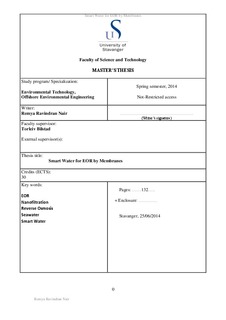| dc.contributor.author | Nair, Remya | |
| dc.date.accessioned | 2014-10-02T13:37:15Z | |
| dc.date.available | 2014-10-02T13:37:15Z | |
| dc.date.issued | 2014-06-26 | |
| dc.identifier.uri | http://hdl.handle.net/11250/222878 | |
| dc.description | Master's thesis in Environmental technology | nb_NO |
| dc.description.abstract | Design of smart water for carbonate reservoir, using membrane process is the focus of the thesis. The desirable characteristics of smart water is low salinity or low NaCl concentrations while retaining divalent ions such as Ca2+, Mg2+, SO42- for improving the wettability. Experimental setup of the project consists of a Nanofiltration (NF) and a Reverse Osmosis (RO) membrane system for ion separation.
The retentate from NF is selected as the main constituent of the smart water due to the property of NF to retain the divalent ions. The results of the selected NF membrane show retention of 99 % of SO42-, 61 % of Mg2+, 31 % of Ca2+, 9 % of Na+ and 7 % of Cl- at a feed flow rate of 145 L/h.
A sensitivity test by spiking Na2SO4 in the feed seawater has shown interesting results of decrease in retention of Cl- with an increase of sulphate concentration. The results also show a reduction in permeate flux as the concentration of Na2SO4 increases.
The RO experiments have produced permeate with TDS level as low as 1620 ppm from the filtered seawater having a TDS level of 30200 ppm. The comparison of NF and RO experiments has confirmed the selectivity of NF to retain divalent ions at a low operating pressure for NF.
The challenge in producing the smart water requirements is the high TDS left in the retentate by NF. In order to overcome this, three options to dilute the retentate is evaluated in the thesis. The options under consideration are combinations of NF with RO, MSFD (Multi-stage flash distillation) and fresh water. The dilution ratio depends on the tolerable limit of total TDS for smart water and at the same time, retaining the divalent ions in the retentate.
Mixing of NF retentate with fresh water (0.43 kWh/m3) emerges as the optimal option in terms of minimum energy consumption for smart water production. However, due to the constraints on availability of fresh water and its socio-environmental impact, the combination process of NF and RO (3.84 kW h/m3) is proposed as the viable process for producing smart water. This option has the benefit of less environmental impact by reduced energy consumption and no chemical addition. | nb_NO |
| dc.language.iso | eng | nb_NO |
| dc.publisher | University of Stavanger, Norway | nb_NO |
| dc.relation.ispartofseries | Masteroppgave/UIS-TN-IMN/2014; | |
| dc.subject | teknisk miljøvern | nb_NO |
| dc.subject | sjøvann | nb_NO |
| dc.subject | smart water | nb_NO |
| dc.title | Smart water for eor by membranes | nb_NO |
| dc.type | Master thesis | nb_NO |
| dc.subject.nsi | VDP::Technology: 500::Environmental engineering: 610 | nb_NO |
